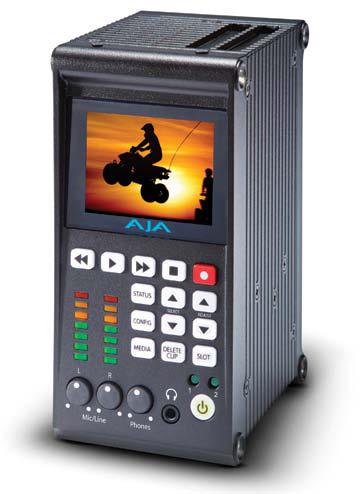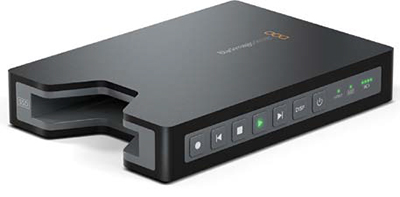Portable Storage Looks Skyward

AJA KI Pro Quad
SAN FRANCISCO—As recording technology shrinks in size, it grows in power and capability. Is it now heading into the wide blue yonder?
These are the questions facing video professionals who head out into the field with today’s modern, ruggedized portable recorders and storage devices. What started as a bulky videocassette in its earliest days of field recording, has shrunk to a palm-size or smaller recording nugget that can be toted nearly anywhere. It can be tucked into one hand or a back pocket, but with the capability to hold hundreds of hours of HD recording material.
Now, broadcasters and media professionals are looking at what might be the next step in portable storage. While no one is claiming the cloud is prepping to whisk storage away from devices on the ground altogether, professionals are considering ways to use cloud technologies to address storage issues in the air.
GLOBAL RESPONSE
Media outlets from Fox to BBC are moving to cloud-based broadcast workflows, testing the ways that cloud technologies can be used to expedite, upload, ingest and deliver media. This new avenue is being opened up to storage as well.
“Large media organizations are trusting the cloud, and Aframe, to move from shoot to edit to air in smarter ways,” said David Peto, CEO of U.K.-based Aframe.
Prime Focus Technologies in Bangalore, India, is one firm investing in cloud technology, and last fall, launched what it calls the industry’s largest digital media cloud-based operation. Known as True North, the operation will include a digital lab for cinema as well as a production hub for television, and will serve as a digital backbone for more than 200 TV channels, showing how a cloud hub may become the de facto virtual hub for television, digital and media companies. That includes potential storage possibilities for both in-the-studio and in-the-field storage needs.
Get the TV Tech Newsletter
The professional video industry's #1 source for news, trends and product and tech information. Sign up below.
“Globally, the market for cloud-based media ERP and media processing services is approximately $5 billion,” said Naresh Malhotra, chairman of Prime Focus. “Our emphasis will now be on the utilization of this already established global digital network.”
The company’s CLEAR enterprise resource-planing (ERP) module includes an option known as “Production on the Cloud,” which includes content acquisition as well as logging capabilities.
Aframe is another company that has grabbed a healthy share of the cloud-based media market, with a sizable solution for storage options in the cloud. The technology is being used to share, scale and back up information, and is increasingly being used in the field to upload media.
“Depending on the case, the cloud will reduce the need for on-premise storage devices and equipment,” said Mark Overington, president of Aframe North America. “In many cases, [a videographer] may shoot and then automatically make a backup copy, which in effect, doubles your storage requirements right there. To be able to shoot and put it up to Aframe, we’re now you’re backup.”
And the “no-hardware” mantra that the cloud holds sacred has its benefits, the company said: The innate ability to handle Gigabytes of video, to transcode video as it is ingested into the system, to be able to share and access video across infinite users.
4K GROWTH
While the industry considers exactly how to use cloud technologies for storage, whether as a primary option or a backup solution, the traditional markers of size and speed remain untouched.

Blackmagic Design HyperDeck Shuttle 2 portable field recorder There’s an ongoing need to address technologies that require higher storage requirements. A number of 4K cameras are proving mobile enough to navigate in the field, and in response, a growing number of portable storage solutions are trying to keep pace. One of those is AJA Video’s Ki Pro Quad, a portable recorder/storage device with file-based recording and playback capability that is designed to accommodate a lens-to-post workflow for 4K projects. Designed with the same side-mounting accessories, the recorder can simultaneously create efficient, edit-friendly 4K ProRes files, output to 4K and HD monitors at the same time, and record data directly to a Thunderbolt-enabled storage system.
That’s just the way the technology is being used in the air by the aerial filming company Helimedia, which includes an arsenal of specialized filming equipment that supports 4K workflows, including portable storage technology.
“Ki Pro Quad gives us the flexibility to work in 4K when we want to,” said company founder Skip Margetts, “It’s a true future-proof solution.”
Size matters, too, for solutions like the HyperDeck Shuttle 2 portable field recorder. The 4:2:2 video recorder from Blackmagic Design offers ProRes, DNxHD or uncompressed recording direct to SSDs with 10-bit video quality. Addressing the little details too, a mounting plate secures the recorder directly to the camera or battery pack.
Other new solutions are addressing high-speed data transfer in the field. Sony recently introduced a new line of 256 GB solid-state drives and two hard disk models that have capacities of 500 GB and 1 TB. Each drive features a USB and two FireWire 800 interfaces, which allow the transfer of video at up to 400 MBps*, allowing users to transfer approximately 30 GB of video to an SDD drive in less than 90 seconds. Designed for rigorous field work, the drives have heavy silicon covers and protective cases and—assuming a videographer wanted to truly test the drives and balance them atop his head—the ability to absorb a 6-foot drop.
Managing high-speed storage when in the field is also the goal of solutions like the Sonnet Fusion F3, which is designed for on location work and features a 6TB, two-drive hardware RAID storage system with a half-RU-wide enclosure with front-panel controls. Designed to facilitate high-speed storage when on location, the drive’s aluminum and steel case is designed to withstand rough handling, and each of the F3 drives is mounted on its own multi-axis shock vibration isolation sled to try and eliminate vibration problems.
*corrected from previous version.
Susan Ashworth is the former editor of TV Technology. In addition to her work covering the broadcast television industry, she has served as editor of two housing finance magazines and written about topics as varied as education, radio, chess, music and sports. Outside of her life as a writer, she recently served as president of a local nonprofit organization supporting girls in baseball.

